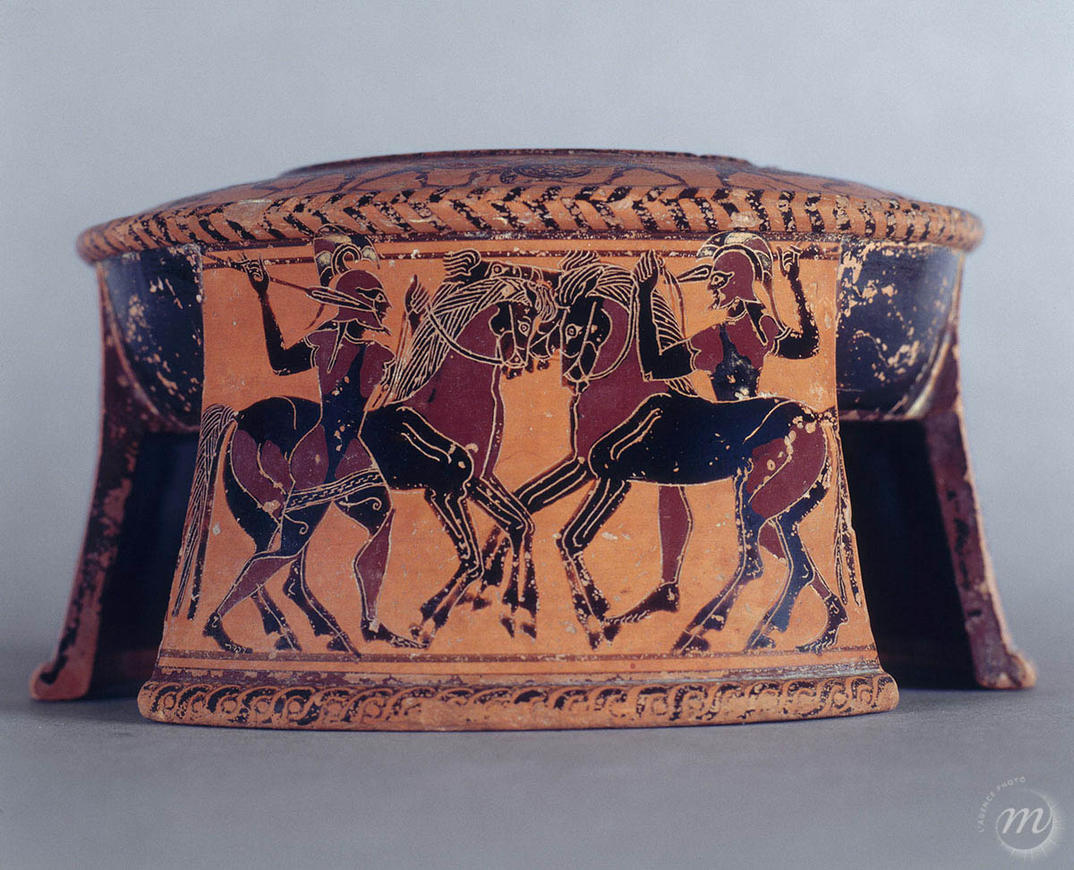Ancient Greece produced an impressive number of ceramics. Any person who was relatively wealthy at that time, whether Greek, Roman or Gallic, wanted to own them. Vases were the perfect media upon which to recount the ancient myths, that is to say, the stories of the lives of the gods and heroes. The decoration was painted using a technique called "black figures". The difference in colour between the background and the decoration was obtained by three successive firings. The incisions in the dresses and head-dresses brought out the light colour below.
We can identify some of the artists who decorated these vases. This is the case of the vase preserved at the Palais des Beaux-Arts in Lille. The originality of the painting, the way the decoration is laid out and the choice of the symbols of office borne by the gods, have made it possible to compare our vase with other ceramics. This painter's style is close to that of the artists of Corinth ( an important city in the centre of Greece). Unfortunately, he never signed his creations: consequently, he was nicknamed "Painter C".
Among the vases he created, three of them possess this very peculiar form. The central basin is mounted on three feet, which is reminiscent of makeup boxes. The vessel would then be used to contain oils or scented ointments.
But for what purpose? Could it have been a gift offered to a young bride so she could charm her husband with her sweet smell? Or a vessel that was used in the final cleansing of a dead man and then deposited by his side? It could perhaps have been given as an offering to the goddess Athena, who appears several times in the decoration. This deity was the subject of a major cult in Athens at the time the vase was made. To this day, it remains a mystery!
(Inventory number: Inv. Ant 763 )

Ancient Greece produced an impressive number of ceramics. Any person who was relatively wealthy at that time, whether Greek, Roman or Gallic, wanted to own them. Vases were the perfect media upon which to recount the ancient myths, that is to say, the stories of the lives of the gods and heroes. The decoration was painted using a technique called "black figures". The difference in colour between the background and the decoration was obtained by three successive firings. The incisions in the dresses and head-dresses brought out the light colour below.
We can identify some of the artists who decorated these vases. This is the case of the vase preserved at the Palais des Beaux-Arts in Lille. The originality of the painting, the way the decoration is laid out and the choice of the symbols of office borne by the gods, have made it possible to compare our vase with other ceramics. This painter's style is close to that of the artists of Corinth ( an important city in the centre of Greece). Unfortunately, he never signed his creations: consequently, he was nicknamed "Painter C".
Among the vases he created, three of them possess this very peculiar form. The central basin is mounted on three feet, which is reminiscent of makeup boxes. The vessel would then be used to contain oils or scented ointments.
But for what purpose? Could it have been a gift offered to a young bride so she could charm her husband with her sweet smell? Or a vessel that was used in the final cleansing of a dead man and then deposited by his side? It could perhaps have been given as an offering to the goddess Athena, who appears several times in the decoration. This deity was the subject of a major cult in Athens at the time the vase was made. To this day, it remains a mystery!
(Inventory number: Inv. Ant 763 )